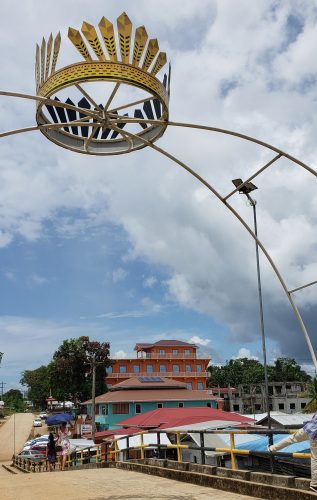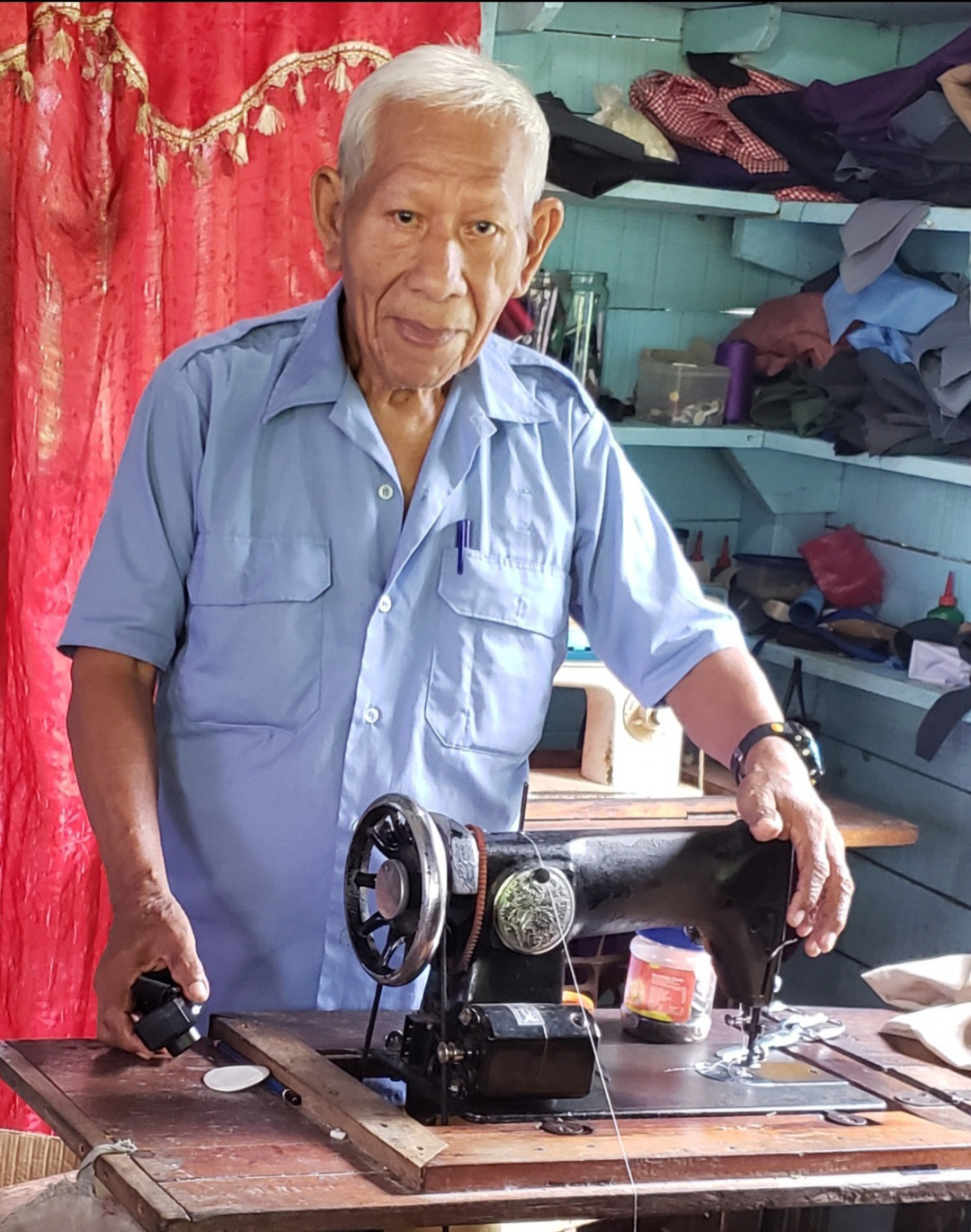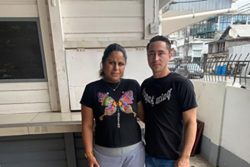Everyone in Santa Rosa knows Stanislaus ‘Aloysius’ Torres as Aloysius or ‘Uncle Sackie’. It was only when he got his birth certificate and had to vote as an adult that he found out his first name was in fact Stanislaus.
A tailor for 61 years and a long-serving village councilor, Torres, 78, has seen the village grow exponentially and thinks it is poised to be upgraded to a township with its commercial, business and social services.
“I would suggest that Santa Rosa village, the administrative centre for the sub-region, be made into the first full-fledged Amerindian township with its own laws and regulations governed under a revised Amerindian Act. That would be a challenge but it can be done,” he said in an interview with Stabroek Weekend.

He noted that both Lethem and Mabaruma combined do not have half the population of Santa Rosa, which is estimated at some 12,000.
Noting that Santa Rosa needs a banking facility, he said the issue of establishing a branch of a commercial bank was raised at community meetings with government officials but nothing has come out of the idea. “People from all over Moruca go to Charity or Anna Regina on the Essequibo Coast to do banking. Instead of going through the ocean and the Pomeroon River to the Essequibo Coast, if there is a banking facility at Kumaka they can just come here and transact their business and go back home within a day. From Kumaka to Charity it costs $8,000 for a return trip. That is only for Santa Rosa residents. Villagers from Kwebana and other areas will pay more plus they will incur other costs for travel and accommodation.”
Torres was born at Acquero Health Centre. At the time, there was only a dispenser and a midwife, but the village now has the Kumaka District Hospital staffed with doctors and nurses. “We also have an x-ray department and a mortuary. In the past we had to send emergency cases to Suddie Hospital or to Georgetown and bury the dead as soon as possible.”
Noting improved transportation out of the community, he said, as a youth, it cost $20 to get to and from Georgetown by the launch Moruca Express and the steamer that plied the Kingston, Georgetown to Pomeroon Mouth route in a day and a night. Today one can travel the overland route via the Essequibo Coast and get to Georgetown in about four or five hours or via the Bemichi Airstrip in a small aircraft and get to Georgetown in just over half an hour. Moruca Express was owned by the first captain (toshao) of the area, Rueben Stoby.
Also in his youth, he recalled his brother, Boniface, being the only person bringing a bicycle into the community. “It was a Raleigh bicycle. Afterwards people started bringing in bicycles. At present we have motor bikes, cars and buses. The first vehicle brought into Moruca was a tractor by the second captain, John Ferreira. I have seen changes.
“Santa Rosa is more of a town than a village. Kumaka has all the big businesses. When I was a child and even as a youth, we had three shops. Uncle Ben Stoby ‘Big Shop’ and the Coop Shop run by Bridges Atkinson at Cabucalli, and John Ferreira shop at Kumaka. Now we have big stores, general stores, a mall. Things have changed a lot from then to now.”
Happy that the development in Santa Rosa is led by the Indigenous Peoples themselves, he said, “The Amerindian themselves are developing Moruca. Those owning and operating leading businesses including the passenger boats are not strangers from outside. Put it my way, they are Moruca people.”
In the not so distant past, he said, “We had to go to bed early because there was no electricity in the village. Children studying for exams had to do so by jumbie lamp (flambeau). Today we get electricity into our homes. We also get cell phone calls from any part of the world. In the past we relied on mails coming in by the mail boat once weekly.”
“As councillor I saw a lot of developmental changes in Santa Rosa. The Kumaka-San Jose Bridge being one of them. The current bridge was built by the coalition government and now this government is working on the dam at the San Jose end. A concrete road from the dam to Santa Rosa Primary School is being built and is almost nearing completion. I am happy for that. The road used to be muddy and slushy and a lot of accidents involving bicycles, people sliding and falling and even cars getting stuck. It is just where my workshop is so I saw everything.”
Living near to the bridge, as a child and as a youth he ferried students and farmers to and from San Jose and Kumaka “for free” using a dugout canoe or ‘koryal’ (paddle boats). Sometimes, when there was no boat, students swam across the river with their uniforms in hand above the water to get to and from school.
Challenges, cultural centre
However, he noted the complaints from residents about the poor quality of the internet service in the area. “If we have to keep abreast with development, we need improved internet service, especially for our students and teachers who are doing online courses.”
He has seen many challenges as development took place, more so the loss of cultural identity and the damage to the environment that “was so unique to Moruca.”
To halt this decline, he suggested, the development of a cultural centre for the Moruca sub-region. “We are losing our culture a little too rapidly. Integration is playing a great part in that too. I would like to see the village council having a councillor responsible just for preserving and promoting as much of our cultural heritage. Right now it is only on certain occasions people come out and do a little banchakeli show. It must be continuous. We need to have a centre for culture here in Moruca.”

On fishing, he said, “I could recall, a lot of people used to fish alongside the river with rods or shooting fish with arrows in the river. You don’t find that anymore. The use of a lot of high-powered outboard engines has polluted the river or the speed boats have chased away the fishes.”
Back in his early childhood, he said, people celebrated occasions with the live banchakeli bands using string instruments like the guitar, banjo, quarto, violin and the maracas.
“We moved from string instruments, to the juke box and now computers with the big boom- boom-speaker systems for music. Right now we are trying to preserve the banchekeli culture. Whenever people visit they want us to play. We are getting older every day. The council asked me to teach some youths and I teach them what I know. I started playing after my father, Isidore Torres, who used to teach in the Rupununi, brought home a guitar. My mother used to say he was the first man to bring a guitar to Moruca. We learned to hold the guitar and strum.
We had only the musical instruments to make music to which we partied. We called that the banchakeli. I play for the banchakeli. I never travelled with any contingent to play but when visitors come and they want the music, I organise a little group. I get the violin man, the banjo man, and the shak-shak man and me on the guitar and we make the music. We last played for heritage day.”
A devout Catholic, he is a member of the Santa Rosa RC church and is one of two guitarists in the choir. “We play with the church every Sunday.”
Like the waning of the banchakeli music, Torres has found while there is acceptance for the traditional kadakura (sauce from the cassava water) also known as tuma in other parts of the country, the delicacy is scarce. “At the last heritage day celebrations, a big businessman from Essequibo told me when he comes to Moruca he expects to eat Indigenous foods not roti and curry or bar-b-que chicken. There is a great shortage of cassava root to make cassava bread, kadakura or cassreep. We are not ashamed of cassava.”
Tailoring
Torres started school at the then Santa Rosa Roman Catholic School at seven years. “We had one school building that is still standing. There was no bottom floor. Classes for beginners were held on the ground. We started at ABC and we had classes up to sixth standard in my day. I was successful at the Primary School Leaving Certificate of Education. Twenty-one of us sat the exams and 19 of us passed. I was among the top students. I think at that time we topped the primary schools in passes in Guyana. The year was 1957. I started school in 1951 and I finished my schooling when I was 13 years. I remember the director of education officer at the time was GHR Clough who sent his congratulations to us. The school inspectors came and made the announcement. We had our own celebrations at the school which was run by the Sisters of Mercy and they gave us gifts. It was a big thing for us.”
After leaving school, Torres spent a year at home. He applied for entry to Central High School but by the time he got a reply he was already 14 years and was considered too old for admission. Today Santa Rosa village has three primary schools, a nursery school and nursery departments and a secondary school.
At the time, a nun at the school believed that Torres had the aptitude to do well in training to obtain a skill and she sought admission for him at the Government Technical Institute. “I got through to do motor vehicle mechanics but because of financial constraints I quit after a while.”
At 17 years, his sister, Mary Richards, a nurse/midwife paid for him to take a course in tailoring. “My tutor, Frank Fredericks, told me that I would have taken three months to complete the course but I did it in one month. That was the start of my journey into tailoring and I am still at it after 61 years.”
At first, he found tailoring was boring. “I’d liked going to parties and taking part in social activities. Tailoring kept me in one place. When everyone was going about I was at home cutting cloth and sewing. It was only after I began to mature and became wiser I saw the stability it gave me and merits of the trade.”
He saw friends going out of the community to work in logging and mining. “I even attempted to go out and work like others youths my age. It was nothing good for me. I returned home to tailoring. At one time I was in Georgetown and punishing and a Moruca resident saw me and asked me, ‘What you doing here?’ He paid my passage back home and back into tailoring.”
In the 90s he worked for three years with the mining company Golden Star but after the company folded he returned to Santa Rosa to tailoring.
“After everything I did, tailoring was always there for me. I make suits for men and women. Teachers come and they want blazers and skirts. I make shirts. The only thing I don’t make are dresses.” He makes uniforms and the ties for the students of Santa Rosa Secondary School.
The father of six said none of his children is into tailoring. “I want to hand over the business to them. What I know, I want to pass on to them before it’s too late.”
His clients are from all the villages in the Moruca sub-region.
Though he would have given tips of his trade to a few persons, he has not been involved in training.
“One time the village council asked me to train and I was willing to do it. When I asked for payment they told me I will have to do it voluntarily. I told them I couldn’t do it voluntarily because the classes would have taken away from my earnings. They didn’t follow up with me. They brought someone in from the Essequibo Coast and they paid him.”
Under the APNU-AFC administration, government officials looked at his work and asked if he could conduct classes.
“Like before, I said I would if they pay me. They gave me a ball [park] figure to do the training from 9.00 am to 1.00 pm each day and I agreed but then that government was voted out of office and that was that. I would like to pass on my trade.”
And while, he would like to pass on his skills as a tailor for a stipend, Torres said he has given his fair share of voluntary service to the village as a village councillor for the Santa Rosa Mission and Islands, as a parishioner and as a guitarist. “I live near to the bridge so I did a lot of voluntary work on it and on the dam.”
He was first elected councillor in 1978 and his last term was from 2004 to 2007. He served under several toshaos including Mary Williams, the late John Atkinson, the late ‘Blanco’ Gomes and Basil Cornelius. His son Maurice is now councillor for the area Torres once served.








